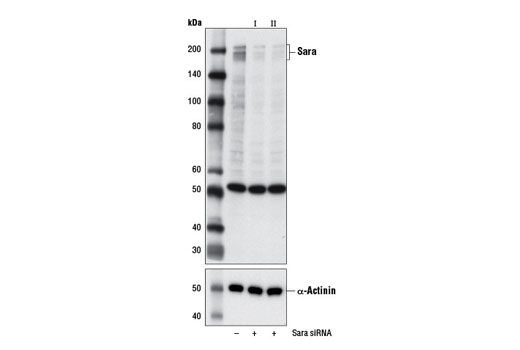#O95405
9372
Product Information
Product Usage Information
CST recommends transfection with 100 nM SignalSilence® Sara siRNA II 48 to 72 hours prior to cell lysis. For transfection procedure, follow the protocol provided by the transfection reagent manufacturer. Please feel free to contact CST with any questions on use.
Each vial contains the equivalent of 100 transfections, which corresponds to a final siRNA concentration of 100 nM per transfection in a 24-well plate with a total volume of 300 μl per well.
Storage
Specificity / Sensitivity
Species Reactivity:
Human
Product Description
Background
The Smad anchor for receptor activation (SARA, ZFYVE9) protein is an FYVE domain-containing protein originally identified as a regulator of TGF-β signaling (1). FYVE domains are zinc finger-like domains that bind to phosphatidylinositol 3-phosphate and are responsible for endosomal trafficking (2). While the role of Sara in TGF-β signaling has been questioned (3,4), early research studies demonstrate that Sara enhances TGF-β signaling by binding and recruiting non-activated Smad2 and Smad3 to the TGF-β receptor complex (1). Upon Smad2 activation, Sara dissociates from the complex while phosphorylated Smad2/3 translocates to the nucleus to bind to the common Smad, Smad4. Sara can also function as an anchor for the protein phosphatase 1 (PP1c) catalytic subunit, which is involved in the Smad7-mediated dephosphorylation of TGF-β type I receptor (5,6). Additional research studies show that expression of Sara plays a critical role in maintenance of the epithelial cell phenotype and that expression is regulated during the epithelial-to-mesenchymal transition (EMT) and fibrosis (7,8).
- Tsukazaki, T. et al. (1998) Cell 95, 779-91.
- Itoh, F. et al. (2002) Genes Cells 7, 321-31.
- Bakkebø, M. et al. (2012) FEBS Lett 586, 3367-72.
- Goto, D. et al. (2001) Biochem Biophys Res Commun 281, 1100-5.
- Bennett, D. and Alphey, L. (2002) Nat Genet 31, 419-23.
- Shi, W. et al. (2004) J Cell Biol 164, 291-300.
- Runyan, C.E. et al. (2009) J Biol Chem 284, 25181-9.
- Zhao, B.M. and Hoffmann, F.M. (2006) Mol Biol Cell 17, 3819-31.
Species Reactivity
Species reactivity is determined by testing in at least one approved application (e.g., western blot).
Cross-Reactivity Key
H: human M: mouse R: rat Hm: hamster Mk: monkey Vir: virus Mi: mink C: chicken Dm: D. melanogaster X: Xenopus Z: zebrafish B: bovine Dg: dog Pg: pig Sc: S. cerevisiae Ce: C. elegans Hr: horse GP: Guinea Pig Rab: rabbit All: all species expected
Trademarks and Patents
使用に関する制限
法的な権限を与えられたCSTの担当者が署名した書面によって別途明示的に合意された場合を除き、 CST、その関連会社または代理店が提供する製品には以下の条件が適用されます。お客様が定める条件でここに定められた条件に含まれるものを超えるもの、 または、ここに定められた条件と異なるものは、法的な権限を与えられたCSTの担当者が別途書面にて受諾した場合を除き、拒絶され、 いかなる効力も効果も有しません。
研究専用 (For Research Use Only) またはこれに類似する表示がされた製品は、 いかなる目的についても FDA または外国もしくは国内のその他の規制機関により承認、認可または許可を受けていません。 お客様は製品を診断もしくは治療目的で使用してはならず、また、製品に表示された内容に違反する方法で使用してはなりません。 CST が販売または使用許諾する製品は、エンドユーザーであるお客様に対し、使途を研究および開発のみに限定して提供されるものです。 診断、予防もしくは治療目的で製品を使用することまたは製品を再販売 (単独であるか他の製品等の一部であるかを問いません) もしくはその他の商業的利用の目的で購入することについては、CST から別途許諾を得る必要があります。 お客様は以下の事項を遵守しなければなりません。(a) CST の製品 (単独であるか他の資材と一緒であるかを問いません) を販売、使用許諾、貸与、寄付もしくはその他の態様で第三者に譲渡したり使用させたりしてはなりません。また、商用の製品を製造するために CST の製品を使用してはなりません。(b) 複製、改変、リバースエンジニアリング、逆コンパイル、 分解または他の方法により製品の構造または技術を解明しようとしてはなりません。また、 CST の製品またはサービスと競合する製品またはサービスを開発する目的で CST の製品を使用してはなりません。(c) CST の製品の商標、商号、ロゴ、特許または著作権に関する通知または表示を除去したり改変したりしてはなりません。(d) CST の製品をCST 製品販売条件(CST’s Product Terms of Sale) および該当する書面のみに従って使用しなければなりません。(e) CST の製品に関連してお客様が使用する第三者の製品またはサービスに関する使用許諾条件、 サービス提供条件またはこれに類する合意事項を遵守しなければなりません。
